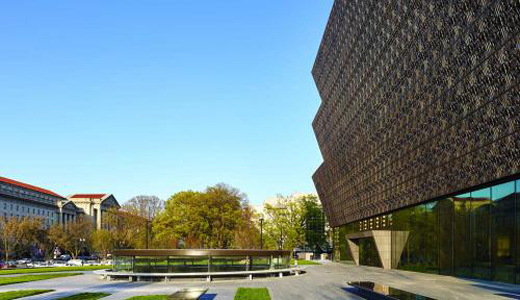
This coming Saturday, Sept. 24, 2016, marks a milestone in the long struggle to recognize the impact that African Americans have had on shaping our country. It’s the Grand Opening of the Smithsonian’s National Museum of African American History and Culture on the National Mall in Washington, D.C.
Efforts to erect such a museum go back as far as 1915, when it was originally proposed by African-American Civil War veterans. Initially authorized by an act of Congress in 1929, the Museum languished for several decades until Rep. John Lewis co-sponsored the legislation to create the Museum in 1988, which he reintroduced every year for 15 years. Finally, in 2003 Pres. George W. Bush signed the law creating the Museum, and Congress promised $250 million to help build it, requiring that it be matched by $250 million from private sources.
The Smithsonian broke ground for the Museum in February 2012: All the decades of persistence will finally pay off on September 24th.
During the Grand Opening celebration weekend, Pres. Barack Obama will speak at the dedication, and the Museum will hold extended visiting hours on Sunday the 25th. “Freedom Sounds: A Community Celebration,” showcasing popular music, literature, dance, and film will also be featured. The celebration will be live streamed on the Museum’s website, nmaahc.si.edu.
Visitors to the Museum will be able to tour 12 interactive galleries that explore the diversity of the African-American experience, from soul-testing presentations like slavery and the Jim Crow era, to African-American achievements in music and sports, to history-making triumphs like the election of Pres. Obama.
The Museum’s inaugural exhibitions will focus on broad themes of African-American history, culture, and community, and will show about 4,000 objects on exhibition from the more than 36,000 historical and cultural artifacts in its growing permanent collection.
The defining architectural feature of the Museum is the three-tiered “corona” that envelops the outside of the building – incidentally, the only building on the National Mall without stone used for the façade. The corona is inspired by the three-tiered crowns used in Yoruban art from West Africa. The bronze-colored metal lattice pays homage to the intricate ironwork that was crafted by enslaved African Americans in New Orleans, Charleston and elsewhere. The Museum offers breathtaking views from numerous vantage points, reaching upward to express the faith, courage, and resilience of the African-American spirit. By night, the corona’s resplendent exterior brilliantly reflects the light from spotlights aimed at it, turning the Museum into a shimmering beacon in the darkness.
Founding Director Lonnie G. Bunch III says, “We are fulfilling the dream to build a living monument to people whose experiences and contributions have so often been left out of our national story through ignorance, neglect, and even overt efforts to suppress accounts of African American struggles and triumphs. I feel that we are delivering on a sacred promise to our African American ancestors by ensuring that their stories will be told and honored.”
“I’m especially proud,” Bunch also states, “that we are the first green museum on the National Mall. Sustainability has always been central to the African-American experience – the idea of making the most of scarce resources. The Museum was built using recycled and recyclable materials. Solar panels on the roof generate electricity, while the corona conserves power by letting in sunlight to illuminate the building’s interior. And the rainwater harvesting system provides water for landscaping irrigation and other uses while reducing storm water runoff. It’s truly state of the art.”
The website for the Museum can be reached here, including information both about the Museum’s contents and the opening ceremonies.
Adapted from the Museum’s Charter Member News, Summer 2016.
Photo: Plaza around the Oculus, which filters light into the belowground Contemplative Court. Alan Karchmer | NMAAHC







